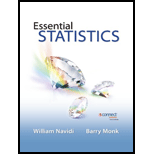
a.
Find the point estimates
a.
Answer to Problem 15CQ
The intercept
The slope
Explanation of Solution
Calculation:
The given information is that the sample data consists of 8 values for x and y.
Slope or
where,
r represents the
Software procedure:
Step-by-step procedure to find the mean, standard deviation for x and y values using MINITAB is given below:
- • Choose Stat > Basic Statistics > Display
Descriptive Statistics . - • In Variables enter the columns of y and x.
- • Choose Options Statistics, select Mean and Standard deviation.
- • Click OK.
Output obtained from MINITAB is given below:
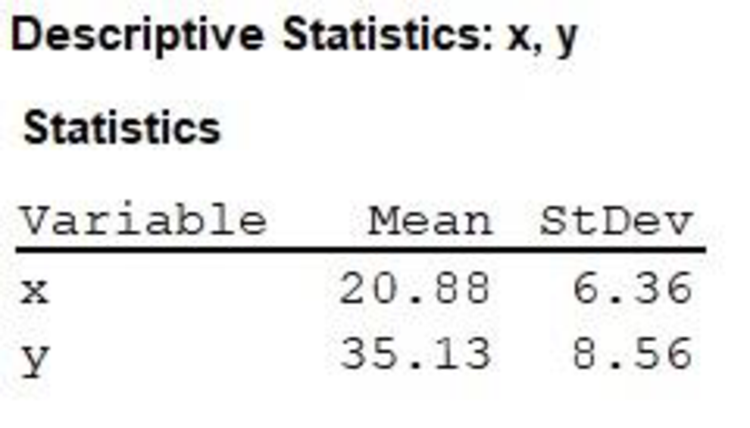
Correlation:
Where,
n represents the sample size.
The table shows the calculation of correlation:
| x | y | | ||||
| 25 | 40 | 4.12 | 4.87 | 0.6478 | 0.56893 | 0.36855 |
| 13 | 20 | –7.88 | –15.13 | –1.239 | –1.7675 | 2.18995 |
| 16 | 33 | –4.88 | –2.13 | –0.7673 | –0.2488 | 0.19093 |
| 19 | 30 | –1.88 | –5.13 | –0.2956 | –0.5993 | 0.17715 |
| 29 | 50 | 8.12 | 14.87 | 1.27673 | 1.73715 | 2.21787 |
| 19 | 37 | –1.88 | 1.87 | –0.2956 | 0.21846 | –0.0646 |
| 16 | 34 | –4.88 | –1.13 | –0.7673 | –0.132 | 0.10129 |
| 30 | 37 | 9.12 | 1.87 | 1.43396 | 0.21846 | 0.31326 |
| Total | 5.4944 |
Thus, the correlation is
Substitute r as 0.7850,
Thus, the slope
Intercept of
Substitute
Thus, the intercept
b.
Construct the 95% confidence interval for
b.
Answer to Problem 15CQ
The 95% confidence interval for
Explanation of Solution
Calculation:
The confidence interval for
Where,
Critical value:
Software procedure:
Step-by-step procedure to find the critical value using MINITAB is given below:
- • Choose Graph > Probability Distribution Plot choose View Probability > OK.
- • From Distribution, choose ‘t’ distribution.
- • In Degrees of freedom, enter 6.
- • Click the Shaded Area tab.
- • Choose Probability and Two tail for the region of the curve to shade.
- • Enter the Probability value as 0.05.
- • Click OK.
Output obtained from MINITAB is given below:
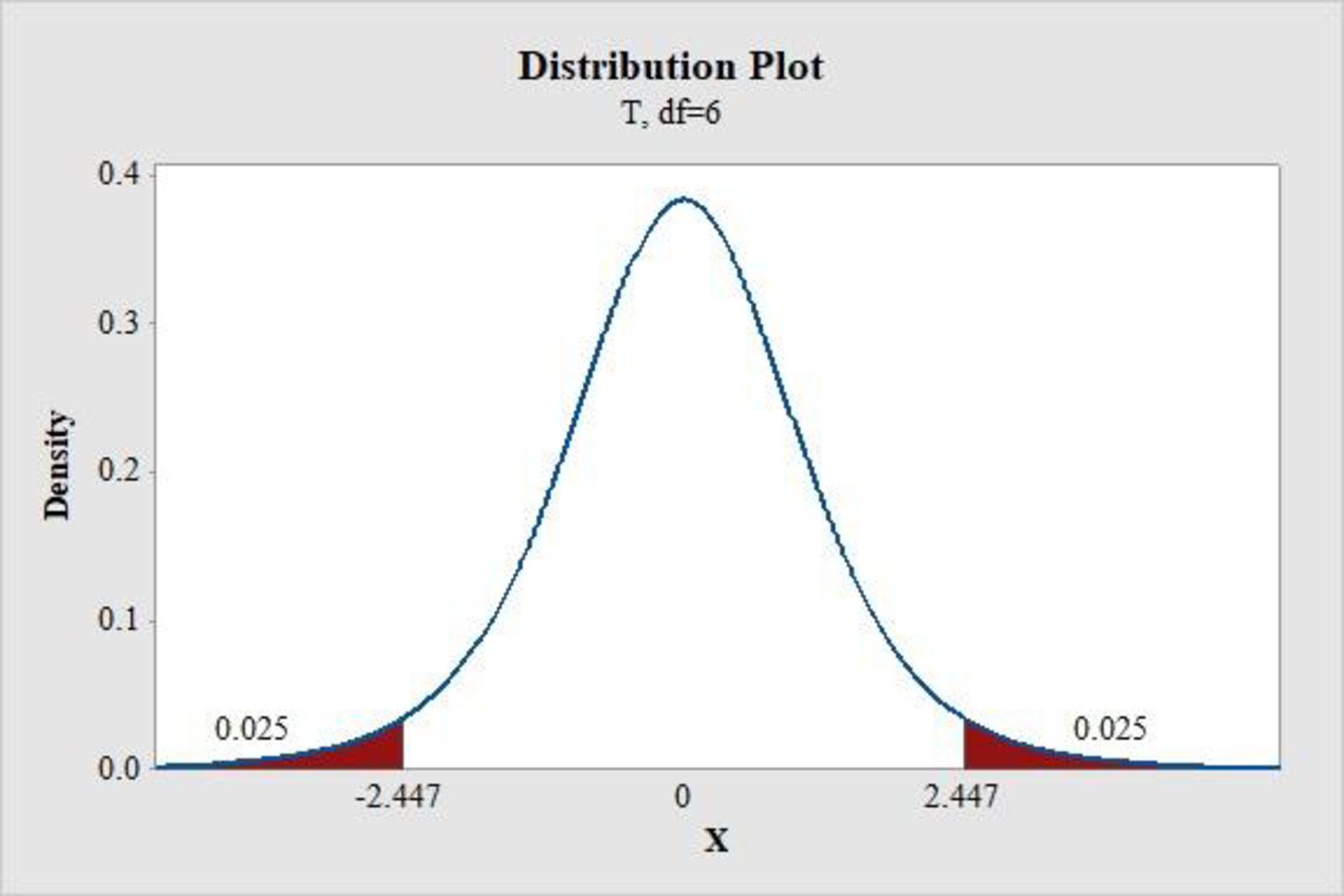
Thus, the critical value for a 95% confidence interval of
The standard error of
Where,
Calculation of residual standard deviation:
Use the estimated regression equation to find the predicted value of y for each value of x and the estimated regression equation is
The table below shows the calculation of residual standard deviation:
| x | y | |||
| 25 | 40 | 39.5 | 0.5 | 0.25 |
| 13 | 20 | 26.78 | –6.78 | 45.9684 |
| 16 | 33 | 29.96 | 3.04 | 9.2416 |
| 19 | 30 | 33.14 | -3.14 | 9.8596 |
| 29 | 50 | 43.74 | 6.26 | 39.1876 |
| 19 | 37 | 33.14 | 3.86 | 14.8996 |
| 16 | 34 | 29.96 | 4.04 | 16.3216 |
| 30 | 37 | 44.8 | –7.8 | 60.84 |
| Total | 196.57 |
Substitute
Thus, the residual standard deviation
The table shows the calculation of sum of squares for x.
| x | ||
| 25 | 4.12 | 16.9744 |
| 13 | –7.88 | 62.0944 |
| 16 | –4.88 | 23.8144 |
| 19 | –1.88 | 3.5344 |
| 29 | 8.12 | 65.9344 |
| 19 | –1.88 | 3.5344 |
| 16 | –4.88 | 23.8144 |
| 30 | 9.12 | 83.1744 |
| Total | 282.88 |
Substitute
Thus, the standard error of
95% confidence interval for
Thus, the 95% confidence interval for
c.
Test the significance of
c.
Answer to Problem 15CQ
There is no support of evidence to conclude that there is a linear relationship between x and y at 1% level of significance.
Explanation of Solution
Calculation:
The hypotheses used for testing the significance is given below:
Null hypothesis:
That is, there is no linear relationship between x and y.
Alternate hypothesis:
That is, there is a linear relationship between x and y.
Test statistic:
Where,
Substitute
Critical value:
Software procedure:
Step-by-step procedure to find the critical value using MINITAB is given below:
- • Choose Graph > Probability Distribution Plot choose View Probability > OK.
- • From Distribution, choose ‘t’ distribution.
- • In Degrees of freedom, enter 6.
- • Click the Shaded Area tab.
- • Choose Probability and Two tail for the region of the curve to shade.
- • Enter the Probability value as 0.01.
- • Click OK.
Output obtained from MINITAB is given below:
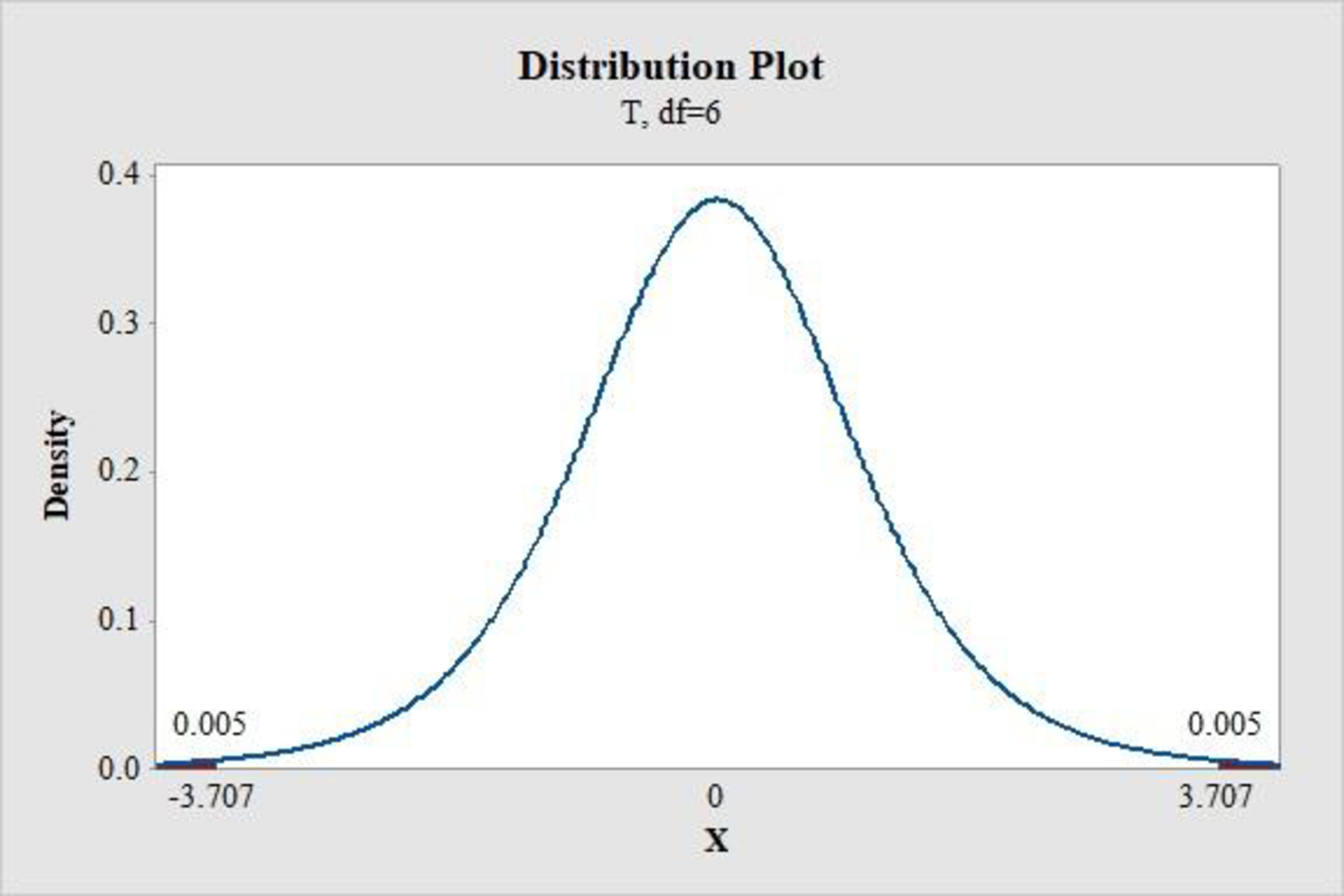
Thus, the critical value for a 99% confidence interval of
Decision Rule:
Reject the null hypothesis when the test statistic value is greater than the critical value for a given level of significance. Otherwise, do not reject the null hypothesis.
Conclusion:
The test statistic value is 3.12 and the critical value is 3.707.
The test statistic value is lesser than the critical value.
That is,
Thus, the null hypothesis is not rejected.
Hence, there is no support of evidence to conclude that there is a linear relationship between x and y at 1% level of significance.
d.
Construct the 95% confidence interval for the mean response for the given value of x.
d.
Answer to Problem 15CQ
The 95% confidence interval for the mean response for the given value of x is
Explanation of Solution
Calculation:
The given value of x is 20.
Software procedure:
Step-by-step procedure to construct the 95% confidence interval for the mean response for the given value of x is given below:
- • Choose Stat > Regression > Regression.
- • In Response, enter the column containing the y.
- • In Predictors, enter the columns containing the x.
- • Click OK.
- • Choose Stat > Regression > Regression>Predict.
- • Choose Enter the individual values.
- • Enter the x as 20.
- • Click OK.
Output obtained from MINITAB is given below:
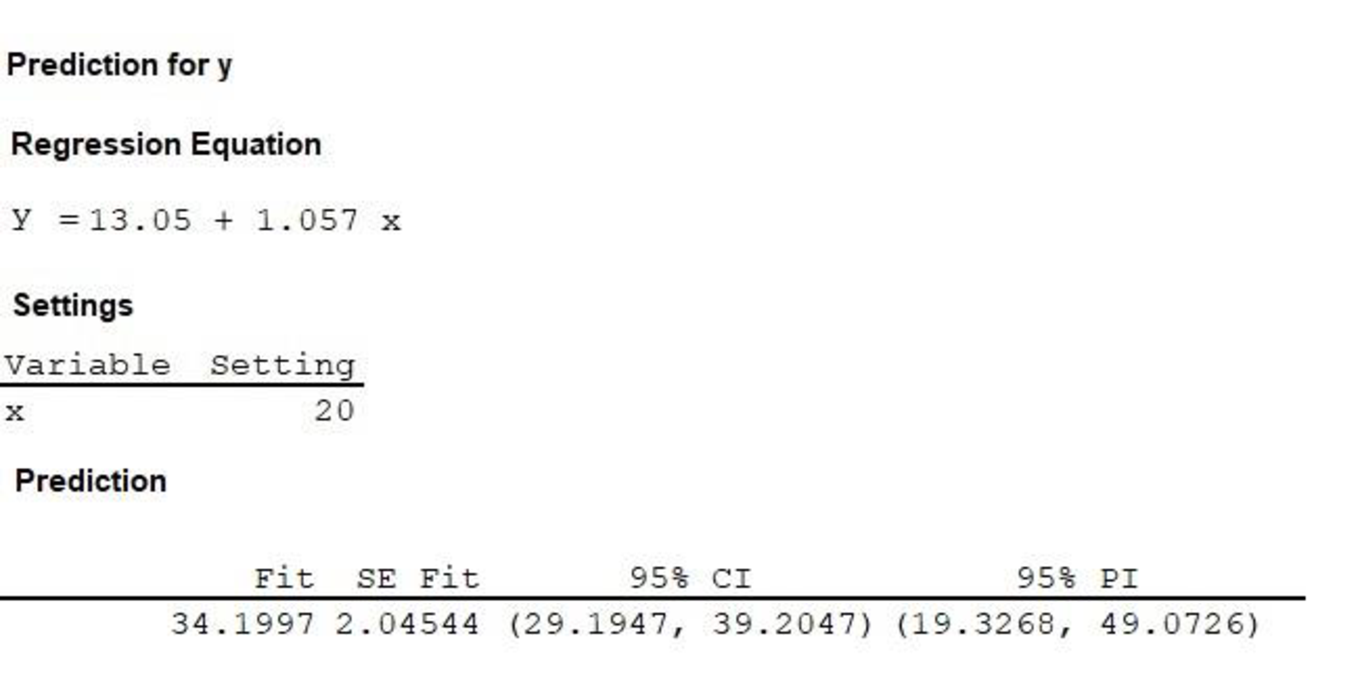
Interpretation:
Thus, the 95% confidence interval for the mean response for the given value of x is
e.
Construct the 95% prediction interval for the individual response for the given value of x.
e.
Answer to Problem 15CQ
The 95% prediction interval for the individual response for the given value of x is
Explanation of Solution
The given value of x is 20.
From the MINITAB output obtained in the previous part (d) it can be observed that the 95% prediction interval for the individual response for the given value of x is
Want to see more full solutions like this?
Chapter 11 Solutions
Essential Statistics
- Client 1 Weight before diet (pounds) Weight after diet (pounds) 128 120 2 131 123 3 140 141 4 178 170 5 121 118 6 136 136 7 118 121 8 136 127 a) Determine the mean change in patient weight from before to after the diet (after – before). What is the 95% confidence interval of this mean difference?arrow_forwardIn order to find probability, you can use this formula in Microsoft Excel: The best way to understand and solve these problems is by first drawing a bell curve and marking key points such as x, the mean, and the areas of interest. Once marked on the bell curve, figure out what calculations are needed to find the area of interest. =NORM.DIST(x, Mean, Standard Dev., TRUE). When the question mentions “greater than” you may have to subtract your answer from 1. When the question mentions “between (two values)”, you need to do separate calculation for both values and then subtract their results to get the answer. 1. Compute the probability of a value between 44.0 and 55.0. (The question requires finding probability value between 44 and 55. Solve it in 3 steps. In the first step, use the above formula and x = 44, calculate probability value. In the second step repeat the first step with the only difference that x=55. In the third step, subtract the answer of the first part from the…arrow_forwardIf a uniform distribution is defined over the interval from 6 to 10, then answer the followings: What is the mean of this uniform distribution? Show that the probability of any value between 6 and 10 is equal to 1.0 Find the probability of a value more than 7. Find the probability of a value between 7 and 9. The closing price of Schnur Sporting Goods Inc. common stock is uniformly distributed between $20 and $30 per share. What is the probability that the stock price will be: More than $27? Less than or equal to $24? The April rainfall in Flagstaff, Arizona, follows a uniform distribution between 0.5 and 3.00 inches. What is the mean amount of rainfall for the month? What is the probability of less than an inch of rain for the month? What is the probability of exactly 1.00 inch of rain? What is the probability of more than 1.50 inches of rain for the month? The best way to solve this problem is begin by creating a chart. Clearly mark the range, identifying the lower and upper…arrow_forward
- Problem 1: The mean hourly pay of an American Airlines flight attendant is normally distributed with a mean of 40 per hour and a standard deviation of 3.00 per hour. What is the probability that the hourly pay of a randomly selected flight attendant is: Between the mean and $45 per hour? More than $45 per hour? Less than $32 per hour? Problem 2: The mean of a normal probability distribution is 400 pounds. The standard deviation is 10 pounds. What is the area between 415 pounds and the mean of 400 pounds? What is the area between the mean and 395 pounds? What is the probability of randomly selecting a value less than 395 pounds? Problem 3: In New York State, the mean salary for high school teachers in 2022 was 81,410 with a standard deviation of 9,500. Only Alaska’s mean salary was higher. Assume New York’s state salaries follow a normal distribution. What percent of New York State high school teachers earn between 70,000 and 75,000? What percent of New York State high school…arrow_forwardPls help asaparrow_forwardSolve the following LP problem using the Extreme Point Theorem: Subject to: Maximize Z-6+4y 2+y≤8 2x + y ≤10 2,y20 Solve it using the graphical method. Guidelines for preparation for the teacher's questions: Understand the basics of Linear Programming (LP) 1. Know how to formulate an LP model. 2. Be able to identify decision variables, objective functions, and constraints. Be comfortable with graphical solutions 3. Know how to plot feasible regions and find extreme points. 4. Understand how constraints affect the solution space. Understand the Extreme Point Theorem 5. Know why solutions always occur at extreme points. 6. Be able to explain how optimization changes with different constraints. Think about real-world implications 7. Consider how removing or modifying constraints affects the solution. 8. Be prepared to explain why LP problems are used in business, economics, and operations research.arrow_forward
- ged the variance for group 1) Different groups of male stalk-eyed flies were raised on different diets: a high nutrient corn diet vs. a low nutrient cotton wool diet. Investigators wanted to see if diet quality influenced eye-stalk length. They obtained the following data: d Diet Sample Mean Eye-stalk Length Variance in Eye-stalk d size, n (mm) Length (mm²) Corn (group 1) 21 2.05 0.0558 Cotton (group 2) 24 1.54 0.0812 =205-1.54-05T a) Construct a 95% confidence interval for the difference in mean eye-stalk length between the two diets (e.g., use group 1 - group 2).arrow_forwardAn article in Business Week discussed the large spread between the federal funds rate and the average credit card rate. The table below is a frequency distribution of the credit card rate charged by the top 100 issuers. Credit Card Rates Credit Card Rate Frequency 18% -23% 19 17% -17.9% 16 16% -16.9% 31 15% -15.9% 26 14% -14.9% Copy Data 8 Step 1 of 2: Calculate the average credit card rate charged by the top 100 issuers based on the frequency distribution. Round your answer to two decimal places.arrow_forwardPlease could you check my answersarrow_forward
- Let Y₁, Y2,, Yy be random variables from an Exponential distribution with unknown mean 0. Let Ô be the maximum likelihood estimates for 0. The probability density function of y; is given by P(Yi; 0) = 0, yi≥ 0. The maximum likelihood estimate is given as follows: Select one: = n Σ19 1 Σ19 n-1 Σ19: n² Σ1arrow_forwardPlease could you help me answer parts d and e. Thanksarrow_forwardWhen fitting the model E[Y] = Bo+B1x1,i + B2x2; to a set of n = 25 observations, the following results were obtained using the general linear model notation: and 25 219 10232 551 XTX = 219 10232 3055 133899 133899 6725688, XTY 7361 337051 (XX)-- 0.1132 -0.0044 -0.00008 -0.0044 0.0027 -0.00004 -0.00008 -0.00004 0.00000129, Construct a multiple linear regression model Yin terms of the explanatory variables 1,i, x2,i- a) What is the value of the least squares estimate of the regression coefficient for 1,+? Give your answer correct to 3 decimal places. B1 b) Given that SSR = 5550, and SST=5784. Calculate the value of the MSg correct to 2 decimal places. c) What is the F statistics for this model correct to 2 decimal places?arrow_forward
 MATLAB: An Introduction with ApplicationsStatisticsISBN:9781119256830Author:Amos GilatPublisher:John Wiley & Sons Inc
MATLAB: An Introduction with ApplicationsStatisticsISBN:9781119256830Author:Amos GilatPublisher:John Wiley & Sons Inc Probability and Statistics for Engineering and th...StatisticsISBN:9781305251809Author:Jay L. DevorePublisher:Cengage Learning
Probability and Statistics for Engineering and th...StatisticsISBN:9781305251809Author:Jay L. DevorePublisher:Cengage Learning Statistics for The Behavioral Sciences (MindTap C...StatisticsISBN:9781305504912Author:Frederick J Gravetter, Larry B. WallnauPublisher:Cengage Learning
Statistics for The Behavioral Sciences (MindTap C...StatisticsISBN:9781305504912Author:Frederick J Gravetter, Larry B. WallnauPublisher:Cengage Learning Elementary Statistics: Picturing the World (7th E...StatisticsISBN:9780134683416Author:Ron Larson, Betsy FarberPublisher:PEARSON
Elementary Statistics: Picturing the World (7th E...StatisticsISBN:9780134683416Author:Ron Larson, Betsy FarberPublisher:PEARSON The Basic Practice of StatisticsStatisticsISBN:9781319042578Author:David S. Moore, William I. Notz, Michael A. FlignerPublisher:W. H. Freeman
The Basic Practice of StatisticsStatisticsISBN:9781319042578Author:David S. Moore, William I. Notz, Michael A. FlignerPublisher:W. H. Freeman Introduction to the Practice of StatisticsStatisticsISBN:9781319013387Author:David S. Moore, George P. McCabe, Bruce A. CraigPublisher:W. H. Freeman
Introduction to the Practice of StatisticsStatisticsISBN:9781319013387Author:David S. Moore, George P. McCabe, Bruce A. CraigPublisher:W. H. Freeman





